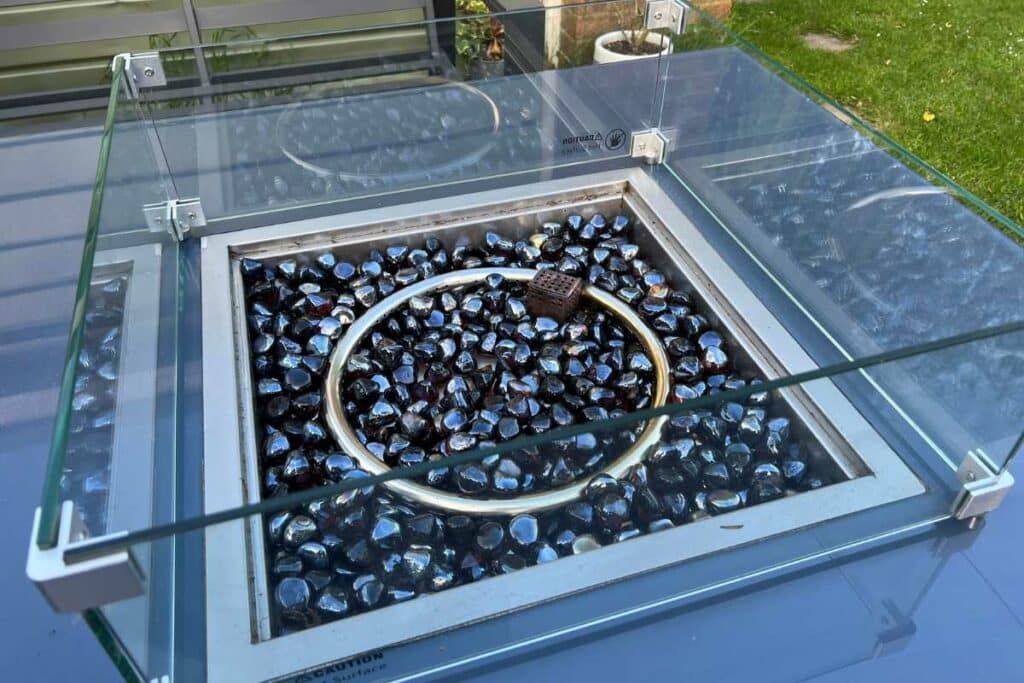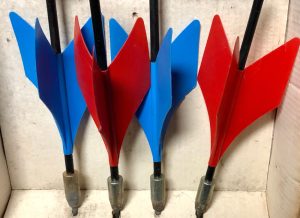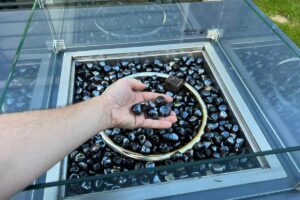Fire pits sure have a way to liven up your outdoor space, making it downright cozy and inviting. But you can add an extra touch of charm and color to your fire feature. That’s right, using fire glass.
Fire glass has the power to elevate your fire feature to a whole new level. It’s specially designed and crafted to be used with gas fireplaces, whether indoors or outdoors. It adds a mesmerizing glow while covering the unsightly gas burners or jets.
This material has become a standard for top-notch designers, homeowners, restaurants, and hotels alike. Whether the flames are blazing or not, it adds appeal to any gas fireplace turning it into a visual masterpiece.
Now, before we go any further, let’s make one thing clear. Fire glass is only meant for gas-fueled features, not wood-burning fireplaces.
Top pick

Stanbroil
Premium Tempering Process with Consistent Jewel-Like Color Throughout, and Ensure Flawless Performance
Editor’s choice

Homeglow
Each cube is 1.5cm x 0.8cm. The cubes are lustrous and glossy on 5 sides, and matte on the back side.
Best Value

Unidanho
Thermally tempered to withstand extreme high temperatures, will not fade, discolor, melt, degrade, pop, crack.
What is fire glass?
So, what in the tarnation is fire glass? Well, let me fill you in on the details.
Fire glass is a collection of small pieces of toughened colored glass, specially made for gas fireplaces or fire pits.
Now, how do they make this stuff?
It’s a process. It starts by taking pieces of different-sized glasses and heat-treating them. This heat-treating process is known as tempering.
You see, when glass is heat treated, it becomes about four times stronger than regular glass of the same thickness. It’s tough as nails and can handle intense heat without breaking, melting, or exploding. It can also resist soot build-up.
But fire glass is not just tough, it’s got style too. Color is added to the glass during the manufacturing process, giving it a vibrant finish. Some of the glass gets tumbled, polished, and cleaned, making it smooth and shiny.
That’s how you end up with a wide range of finishes and vivid colors, from cool blues to lush greens, fiery reds, earthy browns, clear, and even shimmering gold.

Plus, that reflective glass does more than just look pretty. It amplifies the heat output, holding onto that warmth and radiating it outwards. That means you get yourself a more efficient and effective heating experience.
Fire glass is meant to be paired up with natural gas or propane fire pits or fireplace burners. The gas flows through the burner nozzles, through the spaces in the fire glass bed, and to the surface.
Once the gas is ignited, it creates an illusion of the fire glass being on fire. But here’s the thing, the glass itself isn’t burning. It’s purely there for decoration, not as fuel. It needs a fuel source, like natural gas or propane, to keep those flames flickering.
- Natural gas is lighter than air, so it rises above the surface. It burns nice and clean without leaving any soot residue on that fancy fire glass.
- Propane gas is denser than air, so it needs air vents to disperse it closer to the surface. The gas mixes with the air before it ignites above the burner. Now, propane might leave a bit of soot residue on the glass over time but it is easy as pie to clean up.
But hold on. Not all glass is cut out for fire pits. Regular glass can shatter and explode when exposed to intense heat. Fire glass is designed to be tough. It can handle that heat without breaking, cracking, or melting.
When using fire glass, be sure to give the burner of gas jets good and even coverage. You want the gas to flow freely and fuel the flames on the surface.
Types Of Fire Glass
Shapes & Styles
When it comes to fire glass, the options are vast. You can find all sorts of shapes and styles to suit your fancy. We’re talking round glass nuggets, beads, pebbles, cubes, starfish, and even jelly bean-shaped fire glass.
Let’s break it down:
- Jagged/Angular Fire glass is a classic option that sparkles in the flames.
- Fire glass beads: These beauties have a uniform bead-style shape and texture reminiscent of jelly beans and flattened marbles. They often come with a translucent finish.
- Diamond-shaped fire glass: Just like its name suggests, this glass is shaped like a diamond. It’ll give your fire feature a touch of luxury and a lustrous appeal.
- Fire cubes: These pieces are square-shaped with clean and smooth edges.
- Fire dots: These small pieces fit together to create a subtle flame.
Now, bear in mind that different manufacturers might have fancy names for their products. Just keep an eye out for the style that catches your eye.
Fire Glass colors
When it comes to fire glass, the colors are as diverse as the wildflowers in a meadow. Here are a few examples:
- Blue fire glass: It’ll give your fire feature a cool and calm vibe.
- Gray and black fire glass: For a touch of sophistication and drama.
- Golden, brown, or copper fire glass: Adds a warm and earthy feel to your space.
- Green fire glass: Brings in the freshness of nature.
- Clear, silvery, or white fire glass: For that touch of elegance and simplicity.
Now, choosing the type and color of fire glass takes a bit of thought. Consider the dominant color in your space and decide if you want to match or complement it.
Warm colors like orange, red, and yellow make a space more inviting. Cool colors like green, blue, and purple bring a sense of serenity. And if you want a touch of opulence, go for gold, clear, or silver shades. Mix 2 or more colors if you fancy—just make sure they complement each other.
Size Options
Once you’ve settled on the type and color, it’s time to think about size. Fire glass comes in different sizes, from 1/4″ to 1″. Remember, size refers to the thickness of the glass, not the length of the pieces.
- 1/4″ to 3/8″ Fire Glass: Perfect for a smaller and more casual flame.
- 1/2″ to 3/4″ Fire Glass: Ideal for a larger and more dramatic flame.
The half-inch fire glass is the most popular choice for fire pits. But truth be told, there isn’t much difference in functionality and visual appeal between the sizes. It’s all about finding what suits your style and space.
Fire Beads vs. Fire Glass
Fire beads are little gems with a more rounded and uniform shape. They come in standard colors as well as a “luster” finish that gives them a polished and reflective appearance.
On the other hand, we got regular fire glass. This is a classic option made of pieces of glass that are usually flat on both sides. It’s one of the most popular types of fire glass out there.
Regular Glass vs. Fire Glass
Regular glass is not cut out for the heat. It’ll melt, crack, or even pop and send shards flying out of your fireplace. That is not something you want to mess with. Meanwhile, fire glass is built tough. It can withstand the heat without cracking, melting, or exploding.

How to install fire glass
There are a few things to consider while installing fire glass.
First things first, let’s talk safety. When dealing with fire glass, it’s important to handle it with care. Wear gloves, especially if you are working with an angular batch of material. This’ll prevent any cuts from the broken pieces.
How Much Do You Need?
Before making a purchase, you have to figure out how much material you need. There are trusty calculators online that’ll help you with that. All you need is the physical dimensions of your fire feature.
If it’s a rectangle, square, or circle, measuring is a piece of cake. For rectangular or square trays, measure the depth and width.
For circular ones, measure the diameter and depth. Once you got those numbers, plug them into an online Fire Glass Calculator, and voila! You’ll get an estimate of the volume you need.
Installation
Once you got your fire glass shipment in hand, it’s usually good to go. If it has collected some dust during shipping, just give it a quick rinse with water. Make sure it’s nice and dry before you add it to your fire feature.
Now, here are some installation recommendations for different gas fire features:
- DIY Burner Pan: If you’re working on a DIY fire pit burner pan, gently pour that fire glass in. Make sure you create an even layer that extends to the edges. The burner itself should be covered with a thin layer of glass, just enough to hide it. And if you installed a spark igniter, make sure it stays exposed without any glass blocking it.
- Round Paver Style Fire Pit: These fire pits are usually deep. You can use lava rock as filler at the bottom then pour an even layer of fire glass throughout the whole pit.
- Manufactured Fire Pit Tables and Fire Features: It’s best to check in with the manufacturer or seller for specific instructions on adding fire glass. They might have some recommendations tailored to their product. But as a general rule when adding fire glass to a manufactured fire pit, gently pour it around the burner pan. Just be careful not to cover any heat-sensing thermocouple cage.
- Gas-Powered Fireplaces: If you got a gas fireplace, contact the manufacturer to see if fire glass is compatible. Not all fireplaces can handle it. If it’s approved, add an even layer of fire glass around and over the burner. Be mindful of any openings leading to internal components—no blocking those!
- Ethanol or Propane-based Fire Features: Now, for these burners, the fuel needs direct contact with the flame. So, fire glass can only be used as a decorative bed around the fire feature. And if your fire feature has a metal cover that puts out the flame, make sure the fire glass doesn’t interfere with it.
When stacking the fire glass, don’t go higher than 2 inches above the burner, depending on your fire pit or fireplace design. We want to let the flames push through the glass nicely. Aim for uniform coverage across the blazing surface. You can cover the gas nozzles, just don’t hide ’em.
Different fire glass products come with charts that tell you how many pounds you need to be based on your fire feature’s size and style. Always check that user manual for specific instructions.
If you need a depth greater than 2 inches, consider using filler materials like lava balls or cannonballs underneath the fire glass.
You don’t need to go overboard with the quantity. Just make sure to separate the filler material and the fire glass with an aluminum screen.
Place the screen over the lava rocks, keeping the brass jets exposed. When you pour the fire glass, it’ll stay separate from the lava rock. This way, if you ever need to make adjustments or take things apart, you won’t have to sift through a mix of fire glass and lava rock.
Fire glass Maintenance
Maintaining fire glass is a breeze, but it might take some time depending on the quantity.
Over time, that glass might lose a bit of its shine due to residue build-up. No worries, though! Just whip up a 50/50 mixture of water and vinegar.
Take the fire glass out of your appliance and soak it in the solution. That’ll clean off any dust, dirt, or soot that’s accumulated. Afterward, give it a good drying, and it’ll be as good as new.
FAQ
Can You Use Any Glass in a Fire Pit?
You can’t just toss any regular glass in your fire pit and call it a day. Conventional glass is not cut out for the heat—it’ll crack, melt, discolor, or even pop when faced with intense fire. And it can scatter sharp shards, posing a safety risk. Stay away from the regular glass in your fire pit.
If you want to play it safe with a gas or propane fire pit, the only glass you should use is tempered glass. Fire glass is specially treated and tempered to handle scorching temperatures.
Now, fire glass might be a star in gas and propane fire pits, but it’s a no-go for wood-burning fireplaces, stoves, or fire pits.
Is Fire Glass Safe?
Fire glass is made from heat-resistant glass, and it’s completely inert. That means it has no additives or chemicals. It’s tough as nails, unlike regular glass which might melt, fall apart, or even explode. Plus, it won’t give off any toxic or unpleasant fumes.
How Long Does Fire Glass Last?
Fire glass is built to last. It’s designed to withstand those scorching heat without melting, burning, or changing color. On average, you can expect your fire glass to hold up for about 4 to 8 years, but some can go even longer—20 years or more!
Just remember, though, long exposure to sunlight can gradually fade those vibrant colors. To keep it shiny for as long as possible, use a stainless-steel cover to protect your fire pit when it’s not in use.
To Wrap Up
Fire glass is a game-changer. It’s durable, low-maintenance, safe as can be, and it radiates heat.
When you’re ready to make a purchase, check out your local retailers. Places like Lowe’s offer fire glass, both Reflective and Recycled Fire Glass. And hey, if you prefer the convenience of online shopping, plenty of stores have you covered. Place an order and it’ll show up right at your doorstep.
So, there you have it.








